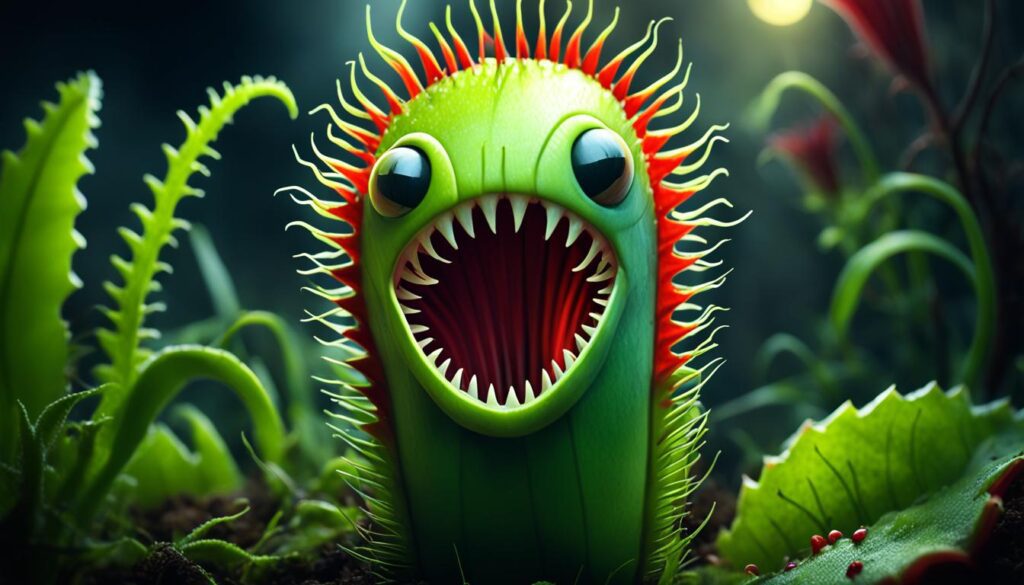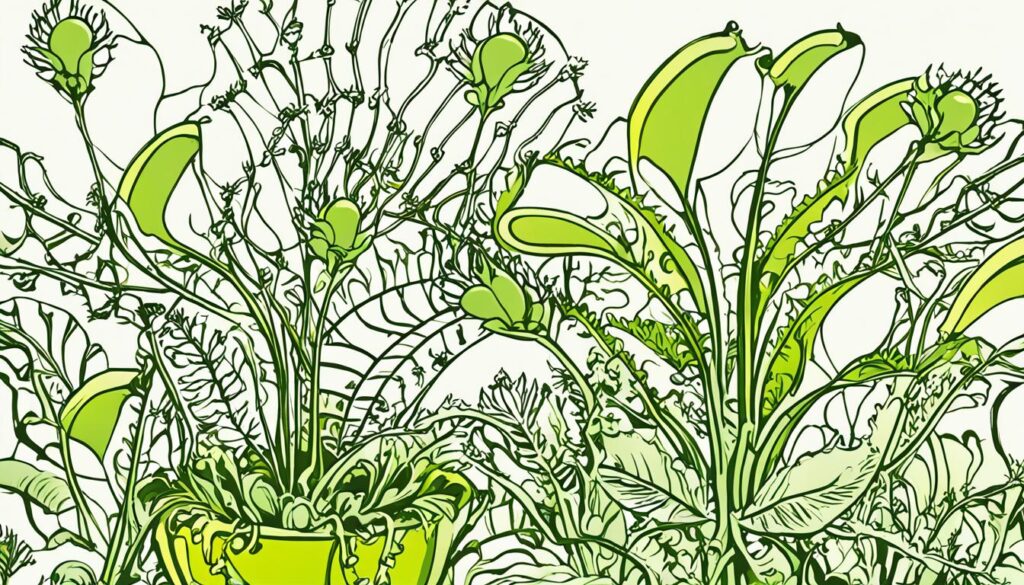The Dionaea Muscipula, commonly known as the Venus Flytrap, is a captivating member of the Droseraceae family, renowned for its remarkable ability to capture and digest prey. As a carnivorous plant, this botanical insectivore has evolved a unique mechanism to attract, capture, and consume insects and other small creatures, making it a true marvel of nature.
The plant’s modified leaves resemble jaws, which close rapidly when an unsuspecting insect touches the sensitive trigger hairs inside the leaves. This remarkable adaptation allows the Dionaea Muscipula to count the number of times its prey makes contact, ensuring a successful capture and subsequent digestion of the nutritional content. This captivating behavior has made the Venus Flytrap a botanical curiosity and a favorite among plant enthusiasts worldwide.
Beyond its dramatic feeding mechanism, the Dionaea Muscipula is also known for its ability to thrive in a variety of environments, making it a highly resilient and adaptable species. This natural pest control marvel, native to the Carolinas, continues to fascinate and inspire botanists, gardeners, and nature enthusiasts alike.
Introduction to the Venus Flytrap
The Dionaea Muscipula, commonly known as the Venus Flytrap, is a captivating carnivorous plant that belongs to the Droseraceae family. This botanical insectivore has evolved a remarkable set of characteristics that allow it to thrive in nutrient-poor environments by supplementing its diet with insects and other small prey.
What is the Dionaea Muscipula?
The Dionaea Muscipula is a unique carnivorous plant that has adapted to capture and digest insects and other small animals. This plant is native to the wetlands of the Carolinas in the United States and is known for its distinctive trap-like leaves that can quickly close around its prey.
Unique Characteristics and Mechanisms
The Dionaea Muscipula, or Venus Flytrap, is renowned for its ability to count the number of times its prey touches its leaves before closing its “jaws” to trap the insect. This complex mechanical and chemical process is what allows the plant to efficiently capture and digest its prey. Additionally, the Venus Flytrap has specialized glands that secrete digestive enzymes to break down the captured insects, enabling the plant to absorb the nutrients it needs to thrive in nutrient-poor environments.
The Venus Flytrap is a true botanical curiosity, captivating the imagination of plant enthusiasts and naturalists alike. Its unique adaptations and mechanisms make it a fascinating example of the incredible diversity and resilience of the natural world.

“The Venus Flytrap is a true marvel of nature, a testament to the ingenuity and adaptability of the plant kingdom.”
Dionaea Muscipula: The Marvel of Nature
The Dionaea Muscipula, more commonly known as the Venus Flytrap, is a true wonder of the natural world. This captivating carnivorous plant, native to the Carolinas, has evolved a remarkable adaptability and resilience that allows it to thrive in a variety of environments.
Adaptability and Resilience
Despite its carnivorous nature, the Dionaea Muscipula can adapt to different soil conditions, temperature ranges, and even varying levels of sunlight exposure. This incredible resilience has made the Venus Flytrap a popular choice for both outdoor gardens and indoor cultivation, as it can flourish in a wide range of settings.
The Dionaea Muscipula’s ability to adapt to diverse conditions is a testament to its evolutionary ingenuity. As a member of the Droseraceae family, this botanical insectivore has developed specialized mechanisms to capture and digest its prey, all while maintaining a remarkable capacity to adapt to its surroundings.
Growing the Venus Flytrap at Home
For those captivated by the Dionaea Muscipula, the opportunity to cultivate a Venus Flytrap at home can be a truly rewarding experience. While it may present some challenges, the satisfaction of watching this carnivorous plant thrive is unparalleled.
When growing a Venus Flytrap indoors, it is essential to provide the proper soil, lighting, temperature, and water conditions to ensure its long-term health and survival. With the right care and attention, this botanical marvel can become a captivating addition to any indoor or outdoor garden, serving as a natural form of pest control and a testament to the wonders of nature.

“The Dionaea Muscipula, or Venus Flytrap, is a true marvel of nature. This plant has evolved remarkable adaptability and resilience, allowing it to thrive in a variety of environments.”
Conclusion
The Dionaea Muscipula, commonly known as the Venus Flytrap, is a captivating and remarkable carnivorous plant that showcases the incredible diversity and adaptability of life on our planet. From its unique mechanisms for trapping and digesting insects to its role in supporting the health of ecosystems, this botanical insectivore from the Droseraceae family is a true marvel of nature.
As a botanical curiosity, the Venus Flytrap not only fascinates us but also offers valuable insights into the complex and interconnected web of life. By understanding and appreciating the Dionaea Muscipula, we can better comprehend the importance of conservation and the preservation of biodiversity, which is crucial for maintaining the delicate balance of our natural world.
Through the study and cultivation of the Venus Flytrap, we can unlock new potential for natural pest control and sustainable practices, further highlighting the value of this captivating carnivorous plant. As we continue to explore and learn from the Dionaea Muscipula, we are reminded of the endless wonders that await us in the natural world, inspiring us to cherish and protect the incredible diversity of life that surrounds us.
FAQ
What is the Dionaea Muscipula?
The Dionaea Muscipula, also known as the Venus Flytrap, is a unique carnivorous plant that belongs to the Droseraceae family. It is famous for its ability to capture and digest prey, making it one of the most fascinating species in the plant world.
What are the unique characteristics of the Dionaea Muscipula?
The Dionaea Muscipula has several remarkable features, including its ability to count the number of times its prey touches its leaves before closing its “jaws.” This triggers a complex mechanical and chemical process that allows the plant to efficiently capture and digest its prey. Additionally, the Dionaea Muscipula has specialized glands that secrete digestive enzymes to break down the captured insects, enabling the plant to absorb the nutrients it needs to thrive in nutrient-poor environments.
How does the Dionaea Muscipula adapt to different environments?
The Dionaea Muscipula, or Venus Flytrap, is known for its remarkable adaptability and resilience. This plant can adapt to different soil conditions, temperature ranges, and varying levels of sunlight exposure, allowing it to thrive in a variety of environments. This resilience has made it a popular choice for both outdoor gardens and indoor cultivation.
How can I grow a Dionaea Muscipula at home?
Growing a Venus Flytrap at home can be a rewarding experience. When cultivating a Dionaea Muscipula, it is essential to provide the proper soil, lighting, temperature, and water conditions to ensure its long-term health and survival. With the right care and attention, this botanical marvel can become a captivating addition to any indoor or outdoor garden.